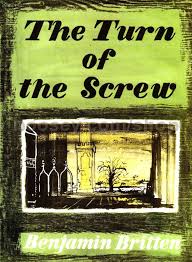by Jarrett Hoffman

Oberlin Opera Theater will bring Britten’s and Piper’s take on the tale to Northeast Ohio this week, turning the stage of Hall Auditorium into the haunted Bly House. Directed by Jonathon Field, conducted by Christopher Larkin, and featuring the Oberlin Chamber Orchestra, performances run at 8:00 pm on Wednesday, Friday, and Saturday — March 7, 9, and 10 — and conclude on Sunday, March 11 at 2:00 pm. The Turn of the Screw will be sung in English and include supertitles. Tickets are available here.
The story centers on an unnamed young Governess, who is hired to care for Miles and Flora, the children of Bly House. But two ghosts — the former valet Peter Quint and former governess Miss Jessel — have returned to possess the children.
One question directors have to ask themselves: how much of it is real? “In the 1930s,” Jonathon Field said in a recent interview, “a critical paper came out that started what’s called the ‘second story,’ in which the Governess is actually hallucinating all of this.” The Henry James story, as Field pointed out, is written largely from the Governess’s first-person point of view. “Britten and Piper both said that for them, the ghosts were real, and since there isn’t that first-person perspective in opera, I’m assuming that the ghosts exist, and that their interaction with the Governess is more real than imagined.”
The Governess’s anonymity is just one oddity about her. “All of the other characters have names, but she only has an occupation, so right there is a little twist,” Field said. “She’s also very imaginative and very susceptible to the way the human mind naturally works, taking one idea and spinning it off into another idea, and then from that into another. After a while she becomes the prisoner of her own doubts and fears, you could say.”

Asked about the ghosts, the director said, “Those guys are just out there. Peter Quint is certainly one of the great bad guys of opera. He’s arrogant and poetic. He ruled the roost at Bly when he was alive, and there are impressions of certain underhanded things that he did with the children, although it’s never quite spelled out. But he definitely also had a relationship with Miss Jessel, and that may have led to her demise. Now they continue this relationship when they’re dead.”
Peter Quint and Miss Jessel present psychological and mortal challenges for the Governess and the children — and practical challenges for staging the opera. “Ghosts are very finicky about where and when they want to appear,” Field said. “We have a scrim in front of the stage for pretty much the entire show, and that enables us to control different areas with light — we can put a person in a part of the stage that is dark, and they will not be seen by the audience until we bring the lights up on them. That’s the theory we’re working under right now, and we just have to fine-tune it.”
Field praised the cast and conductor, adding, “This piece is done so rarely in Northeast Ohio, this will be an excellent opportunity for people to see it and experience what it’s all about.”
Published on ClevelandClassical.com March 5, 2018.
Click here for a printable copy of this article



